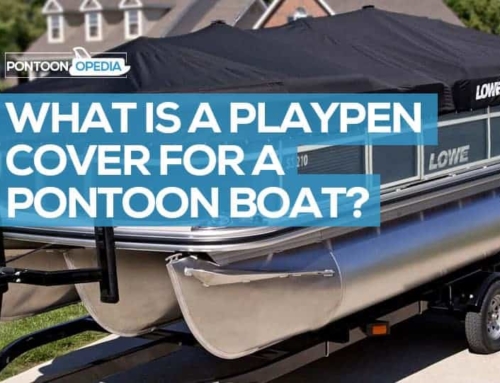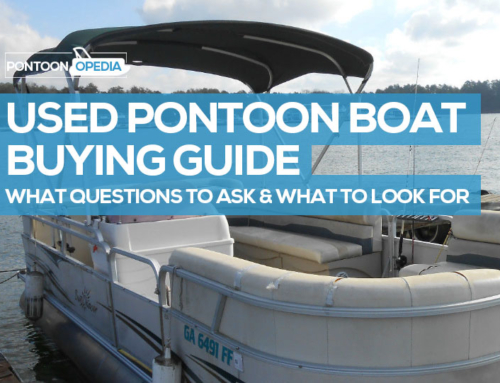If you aren’t familiar with pontoon boats, then the first time you happen to see one raised up on sea legs can be quite an intriguing sight.
I was certainly fascinated the first time, and probably said something like “what the **** is that” as it reminded me of something I might have seen in a James Bond movie.
After having a chat with the family of pontooners who I saw using them, I was actually pretty impressed, and have since done my own research into what they are. Whilst I don’t have them myself, I can see why they would be popular.
So, what are pontoon boat sea legs?
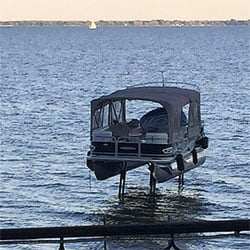
Being used to park in shallow water. (image shared on Facebook, credit unknown).
In simple terms, sea legs are the world’s only portable hydraulic pontoon lift which are designed with two hydraulic lifting legs that are attached to the underside of the pontoon boat. They are an alternative to the classic pontoon lifts that are used at dock.
Sea legs can lift up the boat and hold it at up to a height of six feet so that it is raised out of the water.
Why would you do this though?
Well what it does is protect your boat from the inevitable wear and tear that comes from being in a dock all day or for long periods of time. Being raised out of the water on sea legs will help to keep the value of your pontoon, as your hull will be kept clean from dirt, lake scum, and dents.
But surely you can use a pontoon lift?
True, but pontoon lifts are attached to the dock, so your pontoon boat is only going to be protected when it’s there. The rest of time it won’t be, which is where sea legs can help, as they are attached to the pontoon and can be deployed anywhere as long as they can reach the lake bottom or river bed.
Sea Legs vs Pontoon Lifts
The main selling point advertised by the manufacturers of sea legs is that they are attached to your pontoon all the time, so unlike a lift, you don’t have to be in dock to protect your boat.
Rather than me try and decide what’s best, sea legs or pontoon lifts, I thought instead I would put together my own list of pros and cons and let you decide on whether they are a good purchase or investment for your boat.
Pros
- They can be deployed anywhere providing you aren’t in deep water
- They can help you protect your pontoon and maintain the sell-on value
- They are easier to operate than a lift, you simply push a button
- There are no cables or pulleys to replace unlike on lifts
- They can be fitted to around 90% of pontoons on the market
- In fluctuating water there is no lift to move or adjust, just push a button to change the height
- Unlike lifts where you can damage your pontoon when driving onto them they are already fitted so you don’t have that risk
Cons
- Sea legs are heavy so can affect your pontoon’s performance
- They can have stability issues if the get stuck in mud or the wind picks up
- They cannot be deployed in a lake with a rocky bottom
- You can’t deploy them in water which is more than 5 feet deep
- They can only work on pontoons less than 5,800 lbs in weight
- They can only be fitted on boats between 18 feet and 30 feet in length
- They are an expensive addition to your pontoon
How Much Do Pontoon Sea Legs Cost?
If you are thinking about fitting sea legs onto your pontoon, then you’re going to need bit of money.
The prices below might be a little bit out of date as I took them from a dealer brochure from that time. But, if anything it will give you an indication on what they might cost.
- Standard sea legs (for 2-tube pontoon boats) will cost around $4,995 per set
- Triple Tube sea legs (for 3-tube pontoon boats) will cost around $5,500 per set
If buying from the Sea-Legs company, you will also need to consider the additional cost for the installation jack ($500) and remote control ($350).
Who Sells Pontoon Sea Legs?
There are two main players in the market currently which have a good reputation. They are:
Both of these companies sell products that will attach directly to the underside of your pontoon. You can then lift the boat with a simple touch of a button on a remote control.
Should You Be Concerned About Stability and Performance?
Evidently sea legs are going to be adding a lot of extra weight to your pontoon. On a standard install it could equate to around 2 extra passengers on board, and that is bound to effect performance.
Whilst they do tuck to within 5 inches of the deck bottom, and in theory should not have any implications for drag in the water, it’s the weight that could slow you down.
Having spoken with owners who have pontoon legs on their boat, they have mentioned speed decreases of up to 4 miles per hour.
But then, is speed really something that pontoon owners are concerned about?
Not in most cases, but for those using their pontoon for pulling water skiers and tubing you might notice the difference in performance most.
In terms of stability, I have seen report of pontoons sinking in the mud and tipping. But, this most likely down to the pontooners not taking enough care and attention to where he or she is deploying the sea legs.
You can see some photos below where a pontoon has tipped over whilst being on sea legs.
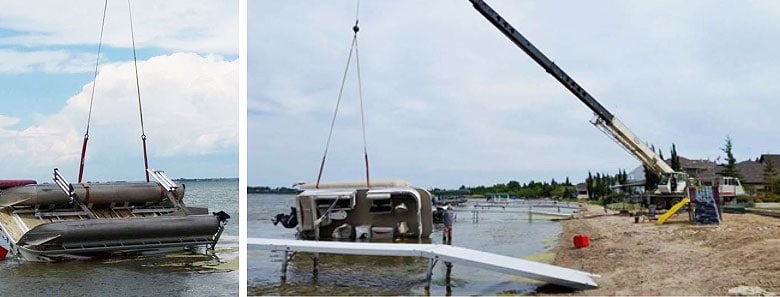
An example of where sea legs were not used correctly leading to instability (image shared on Facebook, credit unknown).
How Many Sea Legs Will Your Pontoon Need?
This depends on the length and weight of your pontoon and they can only be fitted on boats between 18 feet and 30 feet in length.
For most pontoons you will need a pair of legs towards each end of the boat. Larger pontoons may need more. This is only something that the installation company can truly tell you.
Should You Buy Pontoon Sea Legs?
There’s no doubt that by keeping your boat out of the water you can help to keep it in good condition against the water elements and from banging into the dock side.
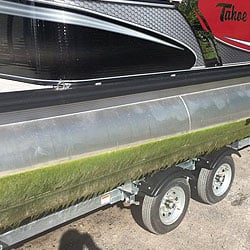
Agh! Scum! (image shared on Facebook, credit unknown).
Who doesn’t want to have a great looking pontoon that hasn’t been bashed to pieces of have scum attached to it?
Also, when you come to sell your pontoon boat, if it’s in a better state, it won’t have depreciated as much, and you’re going to get more money back.
You can use pontoon lifts; they work great to help you keep your boat looking good, but they can have their drawbacks as I showed in the pros and cons above.
Frequently Asked Questions (FAQs)
And finally, some frequently asked questions which should answer anything else that you might have thought about.
To What Type of Boat Can You Install Sea Legs?
They will fit onto the majority of 18 to 28 feet pontoon, whether it’s a new or used boat. The ideal scenario for sea legs are pontoons that have an 8.5-foot-wide decks and 25 inch pontoons.
How Long Have Sea Legs Been Available For?
The Sea-Legs company started in 1996 and say that there are now over 5,000 sets installed across North America. There are other companies who sell similar functioning products such as the Hewitt Pontoon Leg company.
Where Can You Use Pontoon Sea Legs?
They will only work in shallow waters as I described earlier in this article. In terms of application that can mean you can park up on sandbars, at waterside restaurants, shore fishing, or whilst going to get gas for your pontoon. The possibilities are endless as long as you have a firm bed in shallow enough water to operate them.
What is the Lift Height?
The products from the Sea-Legs manufacturer will lift your pontoon six feet, but that it measured from the bottom of the pontoon deck to the river/lake bottom. That’s why it’s important to only use them in shallow water. To raise the pontoon up completely so that it’s totally out of the water, a depth of 4 feet will work.
Will You Need Extra Power?
Aside from a slight dip in performance when operating the pontoon, you won’t need any additional battery to power the sea legs. You will need a battery with at least 750 cold cranking amps.
Do You Need to Winterize Them?
No, you don’t. The manufacturer advice is that you retract them, winterize the motor, and then store the boat away just as you normally would. You don’t need to do anything else.
Where I Can Buy Sea Legs?
Please visit the two manufacturers that I referenced earlier in this article. They will have dealer locator pages which will let you find an approved installer near to you. Please note, this is not something that you can install yourself, and will require an expert engineer.




